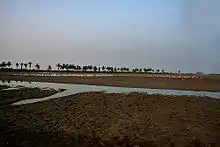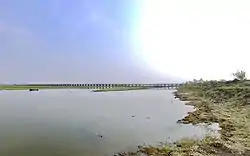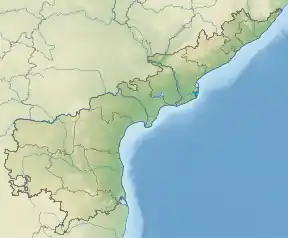Kolleru Lake
Kolleru Lake is one of the largest freshwater lakes in India located in state of Andhra Pradesh and forms the largest shallow freshwater[3] lake in Asia, 15 kilometers away from the Eluru and 65km from Rajamahendravaram, it is located between Krishna and Godavari deltas.[4] Kolleru spans into two districts – Krishna and West Godavari. The lake is fed directly by water from the seasonal Budameru and Tammileru streams, and is connected to the Krishna and Godavari irrigation systems by over 67 major and minor irrigation canals.[5] This lake is a major tourist attraction. Many birds migrate here in winter, such as Siberian crane, ibis, and painted storks. The lake was an important habitat for an estimated 20 million resident and migratory birds, including the grey or spot-billed pelican (Pelecanus philippensis). The lake was declared as a wildlife sanctuary in November 1999 under India's Wildlife Protection Act of 1972, and designated a wetland of international importance in November 2002 under the international Ramsar Convention. The wildlife sanctuary covers an area of 308 km2.[6]

| Kolleru Lake | |
|---|---|
 A bridge over Kolleru | |
 Kolleru Lake | |
| Location | Andhra Pradesh |
| Coordinates | 16°39′N 81°13′E |
| Primary inflows | Ramileru, Tammileru, Budameru, Polaraj drain |
| Primary outflows | Upputeru |
| Basin countries | India |
| Surface area | 90,100 hectares (222,600 acres) [1] |
| Average depth | 1.0 metre (3 ft 3 in) |
| Max. depth | 2.0 metres (6 ft 7 in) |
| Islands | Kolletikota(Heart of Kolleru Lake), Gudivakalanka |
| Settlements | Eluru |
| Designated | 19 August 2002 |
| Reference no. | 1209[2] |
Kolleru Lake under Ramsar Convention (allowing local communities (Here: Vaddi Community) to continue their occupation of culture fish and caught fish) covers 90,100 hectares (222,600 acres) and Kolleru Lake under Wildlife Sanctuary covers 166,000 acres (67,200 ha).[7]
Current state of the lake
Thousands of fish tanks were dug up, effectively converting the lake into a mere drain. This has great impact in terms of pollution, leading to difficulty in getting drinking water for the local people. This is in addition to the loss of ecological diversity and intrusion of sea water into the land masses and its fallout in terms of adverse influence on the rainfall pattern in this region. This imbalance has an adverse effect on the thousands of acres of crops in the upper reaches of the sanctuary, in view of the stoppage of water flow into the sea because of obstruction by the bunds of the fish tanks that have appeared illegally.

Satellite images taken on 9 February 2001 by the Indian remote sensing satellite found that approximately 42% of the 245 km2 lake was occupied by aquaculture, while agriculture had encroached upon another 8.5%. The area under aquaculture consisted of 1,050 fish ponds within the lake and 38 dried-up fish ponds, which together covered an area of 103 km2. The agricultural encroachments were mostly rice paddies. Surprisingly, no clear water could be found in the satellite image. The rest of the lake is diminished by water diversion or is infested with weeds like elephant grass and the water hyacinth.
Rich in flora and fauna, the lake had always attracted migratory birds from Northern Asia and Eastern Europe, between the months of October and March. During this season, the lake used to be visited by an estimated two million birds.
The resident birds include:
- grey pelicans,
- Asian open-bill (Anastomus oscitans),
- painted storks (Mycteria leucocephala),
- glossy ibises and
- white ibises.
The migratory birds include:
- red-crested pochards,
- black-winged stilts,
- pied avocets,
- common redshanks,
- Eurasian wigeons,
- gadwalls,
- great cormorants,
- garganeys,
- purple herons,
- greater flamingos,
- green-winged teals,
- northern pintails and
- northern shovelers.
Kolleru lake contains numerous fertile islets called lankas; many of the small ones are submerged during floods. The origin of the unusual depression which forms the bed of the lake is unknown, but it was possibly the result of an earthquake. Therefore, many ancient villages are precepted in the bed of the lake as a result of floods and earthquake.
History
Two copper plates of the early Pallava dynasty have been found in the lake, tracing its history to Langula Narasimha Deva (Langulya Gajapathi Raju) a Ganga Vanshi Odisha king, (Oddiya/Odia raju)Vaddiya Rajulu/Vaddi. According to legend, the Gajapathi fort was located at Kolleti Kota on one of the eastern islands of the lake. The enemy general "muhammadan" probably a Bahamany general encamped at "Chiguru kota" located on the shores. In some ways, the lake protected the Odia forces. The enemy finally tried to excavate a channel, the modern-day Upputeru, so that the water of the lake would empty into the sea and the level would fall so that they could attack the Gajapathi fort. The royal Odia army general sacrificed his own daughter to propitiate Gods and ensure his success against Muhammadan and her name was "Perantala Kanama". Therefore, the channel was called Perantala Kanama. Sri Peddinti Ammavari Temple is one of the oldest and famous temples found in Kolleru. The Suryavanshi Gajapatis of Odisha, on the height of their power in the 15th century, ruled over a kingdom extending from the Ganges river in the north to the Kaveri in the south under Gajapati Kapilendra Deva. But by the early 16th century, the Gajapatis lost great portions of their southern dominion to Vijayanagar and Golconda.The Gajapatis were a medieval Hindu Suryavamsi dynasty of Kalinga- Utkal Odisha who ruled large parts of Andhra Pradesh, West Bengal, Bihar and Madhya Pradesh. During the glorious reign of Kapilendra deva, the first Suryavamsi Gajapati emperor, the boundary of the Kalinga empire (Ancient Odisha) stretched from river Ganges in North to Kaveri in South and from Amarkantak in West to Bay of Bengal(Kalinga Sagara) in east. This lake has a disaster story regarding a quotation many people use it when they lost everything "Na kompa kolleru aiyindi ". It meant that back in '50s, many of the people of Telaprolu village head family's had invested and bought lands near kolleru lake, but due to expansion of lake, they lost all their properties.
Sanctuary
_at_nest_at_Atapaka_in_Kolleru_W_IMG_3738.jpg.webp)
The sanctuary has the following watch towers for sighting the birds.
Atapaka: 1.5 km from Kaikaluru to see varieties of waterfowl. Murthyraju tank 8 km from Nidamarru East Chodavaram: 25 km from Eluru where openbill storks nest in colonies from July to December.
_in_Kolleru%252C_AP_W_IMG_4052.jpg.webp)
The sanctuary is approachable from all four sides of the lake by road, directly to the following places:
- Atapaka – 2.5 km from Kaikaluru town
- Bhujabalapatnam – 6 km from Kaikaluru
- pallevada −9 km from kaikaluru town
- Kovvada Lanka—7 km from Kaikaluru town *Murthiraju Tanks – 8 km from Nidamarru
- Gudivakalanka – 3 km from Gudivakalanka or 15 km from Eluru, The nearest city by road or rail.
- Prathikola Lanaka or 19 km from Eluru. The nearest city is Eluru, which is 35 km by road.
- Kolletikota −18 km from Kaikalur.
Accommodation
Hotels are available in Eluru, Bhimavaram, Narsapur, Palakollu, Kaikaluru, Akividu, Rajamahendravaram, Vijayawada and Machilipatnam.[8]
References
- Ramsar Convention Ramsar Convention of Kolleru Lake www.ramsar.org
- "Kolleru Lake". Ramsar Sites Information Service. Retrieved 25 April 2018.
- "Kolleru Water Lake". aptdc.gov.in. Retrieved 8 February 2018.
- "Watershed map of east flowing rivers between Godavari and Krishna basins" (PDF). Retrieved 31 March 2016.
- "Worries grow as kolleru shrinks". Retrieved 31 March 2016.
- "Ramsar List" (PDF). Ramsar.org. Retrieved 31 March 2013.
- Ramsar Convention Ramsar Convention of Kolleru Lake www.rsis.ramsar.org
- "Accommodation at vijayawada". Archived from the original on 29 June 2014. Retrieved 6 December 2013.
History of Kolleru: The Imperial Gazetteer of India By Sir William Wilson Hunter, volume ix
External links
- "Kolleru Lake". WWF India. Archived from the original on 9 February 2007. Retrieved 1 June 2018.
- https://web.archive.org/web/20060824182531/http://www.aptourism.com/apservlets/jsp/iplaces3.jsp?&THEME=Wild+Life&LOCATION=Kolleru&DISTRICT=West+Godavari&infoId=217
- Ramana Rao, G.V. (26 May 2006). "Waiting for the birds of good fortune". The Hindu. Retrieved 1 June 2018.
